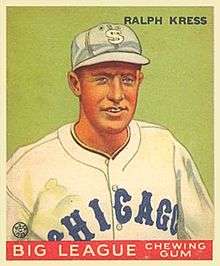Red Kress
| Red Kress | |||
|---|---|---|---|
 | |||
| Shortstop | |||
|
Born: January 2, 1907 Columbia, California | |||
|
Died: November 29, 1962 (aged 55) Los Angeles | |||
| |||
| MLB debut | |||
| September 24, 1927, for the St. Louis Browns | |||
| Last MLB appearance | |||
| July 17, 1946, for the New York Giants | |||
| MLB statistics | |||
| Batting average | .286 | ||
| Home runs | 89 | ||
| Runs batted in | 799 | ||
| Teams | |||
Ralph "Red" Kress (January 2, 1907 – November 29, 1962) was a shortstop and coach in Major League Baseball. From 1927 through 1946, he played for the St. Louis Browns (1927–1932; 1938–1939), Chicago White Sox (1932–1934), Washington Senators (1934–1936), Detroit Tigers (1939–1940) and New York Giants (1946). Kress batted and threw right-handed. He was born in Columbia, California.
Playing career
Throughout his Major League career, Kress was known for his good disposition and perpetual motion. Although he played mostly at shortstop, he showed his versatility playing every position but catcher and center fielder. Kress broke in the majors with the Browns in the 1927 season. In 1929 he led American League shortstops in fielding percentage (.946) and double plays (94), and during three consecutive seasons he batted over .300 with over 100 runs batted in: .305 with 107 in 1929, .313 with 112 in 1930, and .311 with 114 in 1931, including a 22-game hitting-streak in 1930.
Despite his efforts, in 1932 he was traded by St. Louis to the White Sox, who were unveiling Luke Appling at shortstop. Kress therefore adapted to whatever position he had to play, even pitching, in detriment of his offensive production. In the 1934 midseason, he was sent by Chicago to the Washington Senators.
With the Senators, Kress had to compete with Joe Cronin, who was not only the shortstop but the manager. Then Kress became a utilityman, playing in seven different positions, until Bucky Harris released him in 1936.
Kress spent 1937 with the Minneapolis Millers of the American Association, hitting .330 and leading the league shortstops in total chances. He was reacquired by the Browns before the 1938 season. Again at shortstop, he responded with a .302 average and leading American League shortstops in fielding (.965). Traded to the Detroit Tigers in 1939, he broke his leg during the season. In 1940, the American League champion Tigers released the hard-luck Kress on August 1, but he remained with Detroit as a coach through the World Series, then in 1941 continued his career in the American Association as player-manager of the St. Paul Saints of the American Association.
During his minor league days with the Toronto Maple Leafs, Kress played a nine-inning game at nine different positions. While playing against the Montreal Royals in 1945, he pitched a no-hit, no run game for eight one-third innings. But he lost in the ninth, 1–0, on a hit, walk and error.
In 1946, Kress returned to the Majors when he signed with the New York Giants under manager Mel Ott as a player-coach. It was his last year as an active player. In a 14-season MLB career, Kress was a .286 hitter with 1,454 hits, 298 doubles, 58 triples, 89 home runs, 691 runs, 799 RBI, and 47 stolen bases in 1,391 games played.
As a shortstop, Kress posted a .944 percentage as result of 1761 putouts, 2357 assists, and 243 errors in 4361 chances, and also made 558 double plays.
Coaching career
Kress continued as a full-time Giants' coach under Ott and Leo Durocher through 1949. He was a member of the Cleveland Indians' coaching staff for eight years (1953–1960), and then the Los Angeles Angels in their maiden AL season (1961). In addition to the Saints, he also managed minor league clubs such as the Sacramento Solons and Indios de Ciudad Juárez.
Kress returned to New York City, this time to coach for the first-year 1962 Mets under Casey Stengel. The team lost 120 games, the most defeats by a Major League team in a single season since the 19th Century. Almost two months after the season was over, Kress died from a heart attack in Los Angeles, at 55 years of age.
External links
- Career statistics and player information from Baseball-Reference
- Baseball Library
- The Deadball Era